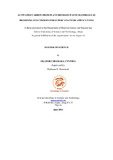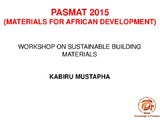Structure and Properties of Organic and Inorganic Composites Materials: From Organic Photovoltaic Cells to Aerospace Materials
Main Thesis
Thesis
Pressure and contacts in materials and systems play crucial roles in their performance and also their eventual failures. Pressure application closes voids, bridges gaps and improves transport across interfaces. In thin film technology of multiple layers which are usually stacked together, photonic and electrical charge transports across the interfaces can have direct consequences on the performance and failures. This study explores the effects of pressure and contacts in bulk heterojunction organic, inorganic and hybrid materials used in photovoltaic applications. We present a review of the state-of-the-art in the theoretical study of the structure of the photovoltaic cells. It involves the application of pressure on contacts between the layers of the organic photo voltaic cells with poly (3-hexylthiophene):phenyl-C61-butyric acid methyl ester (P3HT:PCBM) as the active layer. The contacts between the layers were modeled using analytical concepts and finite element models. The potential effects of surface roughness and dust particles were mod eled along with the effects of lamination pressure and adhesion energy. The results show that, increased pressure is associated with decreased void length or increased contact length. The con tacts associated with the interfaces between the active layer and the hole/electron injection layer poly(3,4-ethylenedioxythiophene: poly styrenesulphonate (PEDOT.PSS) and Molybdenum triox ide (MoO3) are also compared. The implications of the results are discussed for the design of stamping/lamination processes for the fabrication of organic photovoltaic cells. The morphology of active layers of organic photovoltaic cells plays crucial roles in achiev ing good performing devices with longer life span. The study of the active layer materials there fore explored an improved way of processing the active layer to enhance charge transport and lifetime of the conjugated polymer blends. The process of fabricating these devices included post deposition thermal annealing, which increases the crystallinity and enhances phase-separated domains of deposited active layer components. A blended composite of regioregular poly(3-hexylthiophene) (P3HT) and phenyl-C61-butyric acid methyl ester (PCBM) used as the active layer in this Bulk heterojunction (BHJ) photovoltaic cell and annealed at different temperatures coupled with the application of pressure. AFM, SEM and GIWAXS techniques were employed to observe the nano- and micro- structures of the various active layers after quenching to room temperature. A better understanding of the correlation between the observed microstructures and electrical characteristic of the active layers are therefore used to explain the performance of or ganic photovoltaic cells. Finally, Silicon carbide-fiber-reinforced silicon carbide matrix composites (SiC/SiC CMCs) have been proven to possess greater high-temperature strength and durability. These materials are usually used in air breathing engines due to their unique properties. However, the application of SiC/SiC CMCs is ineffective in combustion environment due to oxidation and surface recession. Efforts to improve service of SiC/SiC CMCs in combustion environments require knowledge of their long-term stability in combustion environments, volatility, phase stability, and thermal con ductivity. Therefore in this chapter, the design of a reliable EBC for SiC/SiC CMCs with excellent corrosion, recession and thermal shock resistance is proposed. This design consists of a three-multilayer; yttrium disilicate/mullite/ytterbium disilicate (Y2Si2O7/ 3Al2O3. 2SiO2 /Yb2Si2O7) system. Also, finite element models (FEMs) are used to predict the thermal residual stresses within the proposed multilayers under operating conditions. The implications of the results are discussed for potential application of this EBC system in aerospace engines


